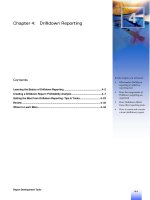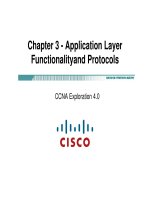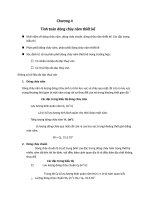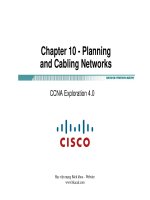Tài liệu Chapter 9 - Ethernet CCNA Exploration 4.0 pptx
Bạn đang xem bản rút gọn của tài liệu. Xem và tải ngay bản đầy đủ của tài liệu tại đây (2.89 MB, 94 trang )
Chapter 9 - Ethernet
CCNA Exploration 4.0
Học viện mạng Bách khoa - Website:
www.bkacad.com
Overview
• Identify the basic characteristics of network media used in
Ethernet.
• Describe the physical and data link features of Ethernet.
• Describe the function and characteristics of the media access
control method used by Ethernet protocol.
• Explain the importance of Layer 2 addressing used for data
Học viện mạng Bách khoa - Website: www.bkacad.com
• Explain the importance of Layer 2 addressing used for data
transmission and determine how the different types of
addressing impacts network operation and performance.
• Compare and contrast the application and benefits of using
Ethernet switches in a LAN as apposed to using hubs.
• Explain the ARP process.
Physical and Data Link Features of Ethernet
• Standards and Implementation
Học viện mạng Bách khoa - Website: www.bkacad.com
Physical and Data Link Features of Ethernet
IEEE (Electrical and Electronics Engineers) Standards
• The first LAN is the original version of Ethernet. Robert Metcalfe and
his coworkers at Xerox designed it more than thirty years ago. The first
Ethernet standard was published in 1980 by a consortium of Digital
Equipment Corporation, Intel, and Xerox (DIX).It was released as an
open standard. The first Ethernet standard products were sold in the
early 1980s.
•
Học viện mạng Bách khoa - Website: www.bkacad.com
• In 1985, the IEEE standards committee for Local and Metropolitan
Networks published standards for LANs. These standards start with the
number 802, and 802.3 is for Ethernet. To compare to the International
Standards Organization (ISO) and OSI model, the IEEE 802.3
standards had to address the needs of Layer 1 and the lower portion of
Layer 2 of the OSI model. As a result, some small modifications to the
original Ethernet standard were made in 802.3.
• Ethernet operates in the lower two layers of the OSI model: the of the
Data Link layer and the Physical layer.
Physical and Data Link Features of Ethernet
Học viện mạng Bách khoa - Website: www.bkacad.com
Physical and Data Link Features of Ethernet
Học viện mạng Bách khoa - Website: www.bkacad.com
Physical and Data Link Features of Ethernet
Học viện mạng Bách khoa - Website: www.bkacad.com
• Media Access Control (MAC) is the lower Ethernet sublayer of the
Data Link layer. MAC is implemented by hardware, typically in the
computer Network Interface Card (NIC).
• The Ethernet MAC sublayer has two primary responsibilities:
– Data Encapsulation
– Media Access Control
• Logical Topology: all the nodes (devices) in that network segment
share the medium. This requires examining the addressing in the
frame provided by the MAC address, and using of CSMA/CD.
Physical and Data Link Features of Ethernet
Học viện mạng Bách khoa - Website: www.bkacad.com
Physical and Data Link Features of Ethernet
• Most of the traffic on the Internet originates and ends with
Ethernet connections. Since its inception in the 1970s,
Ethernet has evolved to meet the increased demand for
high-speed LANs. When optical fiber media was
introduced, Ethernet adapted to this new technology to
take advantage of the superior bandwidth and low error
rate that fiber offers. Today, the same protocol that
Học viện mạng Bách khoa - Website: www.bkacad.com
rate that fiber offers. Today, the same protocol that
transported data at 3 Mbps can carry data at 10 Gbps.
• The success of Ethernet is due to the following factors:
– Simplicity and ease of maintenance
– Ability to incorporate new technologies
– Reliability
– Low cost of installation and upgrade
Physical and Data Link Features of Ethernet
Học viện mạng Bách khoa - Website: www.bkacad.com
Characteristics of Network Media used in Ethernet
Học viện mạng Bách khoa - Website: www.bkacad.com
Characteristics of Network Media used in Ethernet
• Early Ethernet Media: Coaxial cable
– Logical and physical bus topology
– 10BASE5, or Thicknet, used a thick coaxial that allowed for cabling
distances of up to 500 meters before the signal required a repeater.
– 10BASE2, or Thinnet, used a thin coaxial cable that was smaller in
diameter and more flexible than Thicknet and allowed for cabling
distances of 185 meters.
Học viện mạng Bách khoa - Website: www.bkacad.com
distances of 185 meters.
• Now, it was replaced by UTP cables.
– The UTP cables were easier to work with, lightweight, and less
expensive.
– Physical topology was a star topology using hubs. Hubs
concentrate connections. Any single cable to fail without disrupting
the entire network. However, repeating the frame to all other ports
did not solve the issue of collisions.
Characteristics of Network Media used in Ethernet
Học viện mạng Bách khoa - Website: www.bkacad.com
Legacy Ethernet
• In 10BASE-T networks, typically using a hub. This created a shared
media. Only one station could successfully transmit at a time: half-
duplex communication.
• More devices, more collisions.
• Using CSMA/CD to manage collisions, with little or no impact on
performance. As the number of devices and subsequent data traffic
increase, however, the rise in collisions can have a significant impact
on the user's experience.
Characteristics of Network Media used in Ethernet
Học viện mạng Bách khoa - Website: www.bkacad.com
Current Ethernet
• 100BASE-TX Ethernet. Switches replace hubs
• Switches can control the flow of data by isolating each port and sending
a frame only to its proper destination (if the destination is known), rather
than send every frame to every device.
• The switch reduces or minimizes the possibility of collisions.
• Support full-duplex communications (transmit and receive signals at the
same time)
• 1Gbps Ethernet and beyond.
Characteristics of Network Media used in Ethernet
• The applications tax even the
most robust networks. For
example, the increasing use of
Voice over IP (VoIP) and
multimedia services requires
connections that are faster than
100 Mbps Ethernet.
• 1000 Mbps (Gigabit) Ethernet is
Học viện mạng Bách khoa - Website: www.bkacad.com
• 1000 Mbps (Gigabit) Ethernet is
used.
• Some of the equipment and
cabling in modern, well-designed
and installed networks may be
capable of working at the higher
speeds with only minimal
upgrading. This reduces the total
cost.
Characteristics of Network Media used in Ethernet
• The increased cabling
distances enabled by the
use of fiber-optic cable in
Ethernet-based networks
has resulted in a blurring of
the distinction between LANs
and WANs. Ethernet was
initially limited to LAN cable
Học viện mạng Bách khoa - Website: www.bkacad.com
initially limited to LAN cable
systems within single
buildings, and then extended
to between buildings. It can
now be applied across a city
in what is known as a
Metropolitan Area Network
(MAN).
Ethernet Frame
Học viện mạng Bách khoa - Website: www.bkacad.com
Layer 2 addressing and its Impact on Network Operation
and Performance
• The Frame – Encapsulating the Packet
Học viện mạng Bách khoa - Website: www.bkacad.com
Ethernet frame structure
•The Preamble is used for
timing synchronization in the
asynchronous 10 Mbps and
slower implementations of
Ethernet. Faster versions of
Ethernet are synchronous, and
this timing information is
redundant but retained for
compatibility
10101011 •10101011
Học viện mạng Bách khoa - Website: www.bkacad.com
compatibility
•The Destination Address field
contains the MAC destination
address. It can be unicast,
multicast (group), or broadcast
(all nodes)
•The source address is
generally the unicast address
of the transmitting Ethernet
node (can be virtual entity –
group or multicast)
Ethernet frame structure
•The type value specifies the
upper-layer protocol to receive
the data after Ethernet
processing is completed.
•The length indicates the
number of bytes of data that
follows this field. (so contents of
the Data field are decoded per
the protocol indicated)
Length if value < 1536 decimal,
(0x600) need LLC to identify
upper protocol
Học viện mạng Bách khoa - Website: www.bkacad.com
the protocol indicated)
•The maximum transmission unit
(MTU) for Ethernet is 1500
octets, so the data should not
exceed that size
•Ethernet requires that the frame
be not less than 46 octets or
more than 1500 octets (Pad is
required if not enough data)
•Type if value => 1536 decimal,
(0x600) it identify upper
protocol
4
bytes
CRC
Layer 2 addressing and its Impact on Network Operation
and Performance
Học viện mạng Bách khoa - Website: www.bkacad.com
Naming on Ethernet
Học viện mạng Bách khoa - Website: www.bkacad.com
•Ethernet uses MAC addresses that are 48 bits in length and expressed as
12 hexadecimal digits
•Sometimes referred to as burned-in addresses (BIA) because they are
burned into read-only memory (ROM) and are copied into random-access
memory (RAM) when the NIC initializes
Layer 2 addressing and its Impact on Network Operation
and Performance
Học viện mạng Bách khoa - Website: www.bkacad.com
Layer 2 addressing and its Impact on Network Operation
and Performance
• Another Layer of Addressing
Học viện mạng Bách khoa - Website: www.bkacad.com
Layer 2 addressing and its Impact on Network Operation
and Performance
Data Link Layer
• OSI Data Link layer (Layer 2) physical addressing,
implemented as an Ethernet MAC address, is used to
transport the frame across the local media. Although
providing unique host addresses, physical addresses are
non-hierarchical. They are associated with a particular
device regardless of its location or to which network it is
Học viện mạng Bách khoa - Website: www.bkacad.com
device regardless of its location or to which network it is
connected.
• These Layer 2 addresses have no meaning outside the
local network media. A packet may have to traverse a
number of different Data Link technologies in local and
wide area networks before it reaches its destination. A
source device therefore has no knowledge of the
technology used in intermediate and destination networks
or of their Layer 2 addressing and frame structures.









